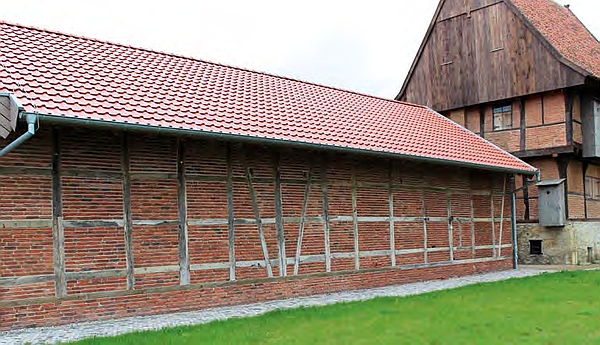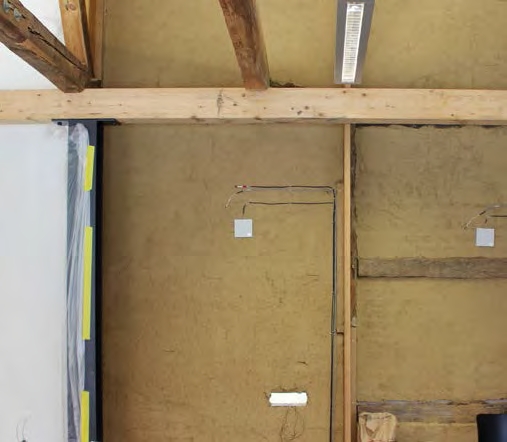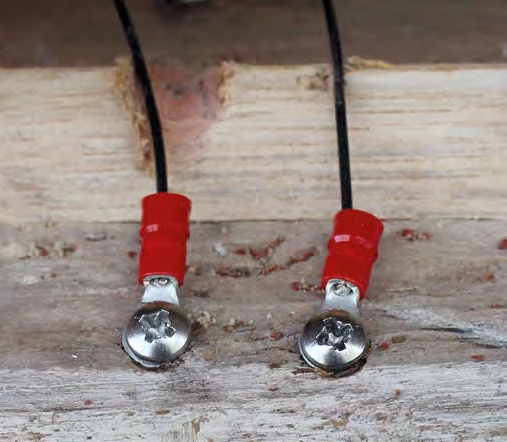Demonstration Center for Energy and Construction



Many people love the cozy look of old half-timbered houses and the rustic charm of their dark-stained beams. But renovating these traditional homes with a view to improving their energy performance is a challenge that calls for experts with specialized know-how.
Typical issues include preventing moisture from infiltrating the wooden structural elements, which could weaken the timber and cause long-term damage to the building fabric. But what are the best insulation materials for half-timbered structures? This question is being investigated by Fraunhofer IBP researchers at the Demonstration Center for Energy and Construction. Created in 2004 by the chamber of crafts and skilled trades (HWK) in Münster with the support of Fraunhofer IBP, the facility consists of several buildings of different styles and a combined exhibition and training center. More recently, HWK Münster acquired Haus Kump, the oldest existing farmstead in the region. While some of the ancillary buildings were demolished and rebuilt, the historical core of the site was protected by a preservation order, and it was here that the demonstration center for the energy-efficient renovation of half-timbered buildings was established. The researchers developed many different solutions for renovating the half-timbered outer walls of the ancient barn, and chose those that were best-suited to this particular project. But before the insulation materials were given a chance to demonstrate their capabilities on a real wall, the scientists carried out a preliminary study using a special software application. To find out which of the materials were most likely to meet the requirements of a half-timbered building, they used WUFI® Pro - a program they had developed many years ago that has since been commercialized and is in use throughout the world. The researchers used climate data sets typical of the region and simulated the performance of the insulation materials over a number of years. What types of weather cause the most problems? And are these problems constant or intermittent over time? With the help of these data, the Fraunhofer IBP researchers were able to optimize the insulation systems accordingly and adapt them to the local conditions.
Acid test for different insulation materials
After carrying out these simulations, the various insulation materials were tested in situ on the walls of the demonstration center. The materials used for interior insulation included a foamed mineral wool, a new aerogel-based material with high insulating properties, insulation materials produced from renewable resources such as cellulose and wood fibers, and a novel, magnesite-bound typha board. In addition to these different types of interior insulation, they also integrated a typha-based system between the timber supports of one section of the façade, providing both interior and exterior insulation, and tested several exterior insulation solutions consisting of typha or mineral fibers clad with weatherproof siding.
The typha-based insulation material, developed jointly by scientists at Fraunhofer IBP and the company typha technik, is the most innovative solution. The raw material is derived from the cattail or bulrush - a marsh plant with distinctive brown fruiting spikes that is often found growing on the edge of lakes. In this instance, the interest lies less in the seed heads and more in the broad leaves which can grow to a height of up to three meters. These leaves have a fibrous supporting tissue, which contributes to the material's mechanical strength, filled with a soft sponge-like tissue which gives it excellent insulating properties. The harvested leaves are bound together using a mineral adhesive to produce a highly stable construction material with low thermal conductivity. An added advantage is that the material is fireproof.
Collecting precise data on physical processes in buildings
Sensors integrated in the insulation measure surface temperature, humidity, heat flow and above all the timberwork's moisture content; in other words, they collect data on the physical processes taking place in the variously-renovated walls of the building. These data are stored in a database for further analysis. How do the different renovation solutions compare in terms of energy performance and physical parameters? In order to take external factors into account, the IMEDAS™ Internet Measurement Data Compilation and Evaluation System developed by the scientists at Fraunhofer IBP was used to analyze data on the outdoor temperature, relative humidity, driving rain and solar radiation. The system consists of a set of software modules for tasks including data acquisition, data evaluation and visualization as well as to monitor measuring stations. The collected data enable the long-term performance of the insulation materials to be evaluated, along with any possible degradation. Employees of the training center run by HWK Münster (HBZ) can also use the web-based IMEDAS™ evaluation software to access these data - giving them a practice-based information system for use in their training courses. Visitors to the demonstration center can view the current status of processes via the online visualization tool, and these preconfigured graphical displays are also available to users of the HBZ intranet.